Tezuka Productions/Sony Pictures Entertainment (Japan) (2003), Sony Pictures Home Entertainment (March 29, 2005), 5 discs, 1010 mins plus supplements, 1.33:1 pan-and-scan, Dolby Digital 2.0, Not Rated, Retail: $34.95
Storyboard:
Astro Boy celebrated his 40th Anniversary in television by starring in a new, state-of-the-art animated series.

The Sweatbox Review:
The original Astro Boy manga named 2003 as the year that Astro Boy was born. Given that we are a few years beyond that now, and that the science of robotics has failed to produce any boy superheroes just yet, it is quaint to look back at where creator Osamu Tezuka thought we might be that year. Of course, the year he chose is not particularly important; he could have chosen any futuristic-sounding year when he first wrote his Tetsuwan Atom stories, and likely picked the year at random. Still, the naming of April 7, 2003 became a self-fulfilling prophecy when a new, modernized Astro Boy series was launched that very day in Japan, in celebration of Astro Boy’s fictitious birth date.
With two successful series in the past, it was important to give the reborn show a new slant, both visually and story-wise. The Japanese creators wanted to stay true to the Tezuka stories, but give them a new interpretation. The series would be a little darker, more complex, but still with a familiar voice. Unfortunately, the needs of the American marketplace (perceived or otherwise, as dictated by the American partners) dulled the efforts of the Japanese writers. Still, they found some common ground and went on to produce a pretty good show.
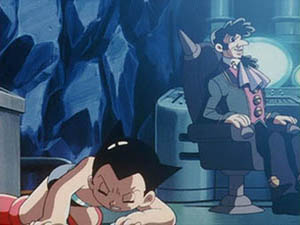
The new series would be closer in many ways to modern anime, a word certainly unknown to Western audiences back when Astro first appeared on television in 1963. The 21st Century Astro Boy show, named Astro Robot Tetsuwan Atomu in Japan, would be sleeker and more polished. The stories would also have a sharper edge and in some ways more sophisticated storytelling. Gone was an origin that could be told in one or two episodes; the 2003 Astro takes several shows to find out about his origins. The first episode actually opens with Dr. Ochanomizu (given the newly-Anglicized name Dr. O’Shay this time around) reviving Astro Boy, while the audience and Astro must wait a while to find out how he was actually created. Meanwhile, Dr. Tenma remains a shadowy figure with a particular interest in Astro Boy. Naturally, longtime Astro Boy fans already generally know the rest of that story, but it is still interesting to see it played out in a different way. Keeping things mysterious was obviously a way to prevent new viewers from skipping any episodes, and as someone who has just been watching the first two series on DVD recently I appreciated the variety.
The revived Astro Boy then follows a similar chain of events, but with new twists. He does acquire human schoolmates and a robot sister (Zoran), and he meets his nemesis “brother” Atlas— now a direct creation of Dr. Tenma. Astro Boy faces a variety of threats to Metro City and to the Earth itself, often relating to robots who have been manipulated by men. One of the most notorious manipulators (aside from Tenma) is again Skunk, a holdover from the 1980 Astro Boy, but no longer sporting green skin. Other ideas get reinterpreted for this version, including a “Frankenstein” robot, a time travel episode, an alien princess, and other familiar plotlines.

In addition, there are other longer story arcs aside from the origin arc. As the series progresses, different factions are introduced that figure into a Robot Revolution storyline: the anti-robot forces of Drake, the rebel forces of the Blue Knight, the military forces of General Red, and of course there is Tenma the mad scientist who believes that robots should rule the world, led by Astro Boy. By the end of the series, the various factions have had a good clash, leading to a final confrontation between Astro Boy and Tenma. Such a grand storyline was certainly never attempted in the earlier shows.
The 2003 Astro Boy does not have the simplistic charm of the 1963 version, nor the melancholy introspectiveness of the 1980 series, but it does keep its stories focused on what Astro Boy is known for. At its heart, this is the story of one society— that of robots— trying to integrate with and be accepted by mankind. Dr. O’Shay is humanity’s largest advocate for robot equality, while Dr. Tenma sees Astro as a natural ruler of mankind. Other villains in the story simply use robots as pawns in their schemes. Fortunately, it is Dr. O’Shay who has the greatest influence on Astro, leading the heroic young robot to using his fame and influence to speak for equality.

Astro Boy was upgraded a bit for this series. Aside from his limbs having rockets for flight, all of his senses have been enhanced. He also has a pretty nifty laser cannon in his arm that helps greatly when fighting large metallic opponents. Other than this, all the characters stay quite true to previous appearances, except for minor clothing alterations.
While some of the episodes seem overly cute or simple, and the plots can seem repetitive when the episodes are watched in bunches, I did enjoy the larger arcs that run through the show. Anytime things center on Tenma or the Robot Rebellion, things get serious and stay interesting. For anyone who has a love of the character, but can be open-minded about a new interpretation, the 2003 version holds up pretty well. The animation is much stronger than before, the special effects are impressive, and Astro is still the naïve innocent trying to get robots and humans to get along. Like its predecessors, this series explores a fascinating world that features healthy doses of both science fiction and fantasy.
After the series was picked up by the WB network for airing in the United States, they only ended up airing 21 of the 50 episodes. YTV in Canada similarly never showed all the episodes. That means that there are a ton of episodes on the DVD set that have never been shown for broadcast in North America. That’s the good news— and you know that when I say that there will be a few unfortunate problems to mention next. The theme song, for one— it was changed from the original Japanese one for the English dub. Then there is the episode order. Rather than follow the actual storyline, the DVD set uses the syndication order, which was… well, screwed up. The flow of the series is interrupted by characters appearing in the wrong sequence (namely Astro’s school friends and his sister), so events do not unfold quite as they should. Many of the episodes are fairly stand-alone anyways, but there are places where things get a little confused. Fortunately, the larger story arcs generally hold together. Worse, though, is that there is a whole episode missing; Eternal Boy has been replaced by a clip show, apparently due to copyright concerns over that character’s similarity with Peter Pan. There will be more bad news in the video and audio sections.
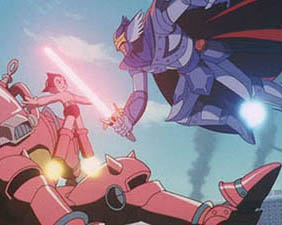
Is This Thing Loaded?
The only real extra is Remaking Of Astro Boy, which sounds like a great behind-the-scenes documentary but only runs 8:23. It may be short, but it does offer some insight into how the show was conceived, highlighting the different needs of the Japanese and American markets. This was an important consideration, since the show was being produced for the international market. What is amazing to me is how candid it is… You actually get to hear how the American story editor asks the Japanese creators to dumb the show down! One Japanese producer relates how the American foolishly asked them, “Why do they have to make a children’s show so sad or dramatic?” To which the producer replies (I’m paraphrasing here), “Because it’s Astro Boy, you dumb so-and-so!” Yep. Pretty typical, eh? So, for anyone who complains that these shows are too simple or lacking that certain Astro Boy quality, it looks like much of the blame has to go to the American backers.
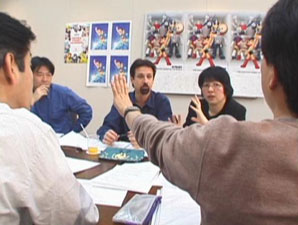
Other than that, there are several Trailers for other Sony Home Entertainment animated product.
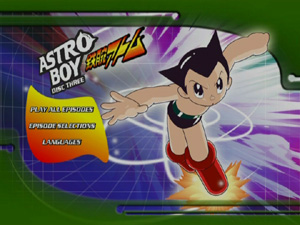
Case Study:
The slipcase is non-descript, having only the title of the show and a head shot on the cover, but the five slimcases inside each have wonderful artwork on them. Synopses for the ten episodes on each disc are split evenly between the back cover of each slipcase and the interior.
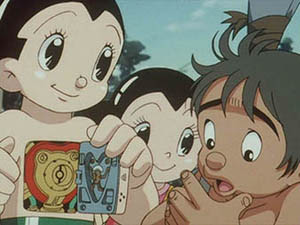
Ink And Paint:
For starters, there is one major problem with this set. The episodes were produced in widescreen, but the image on the DVDs is cropped on the sides to give a 4:3 image (I don’t like saying “fullscreen”, since my TV is not 4:3). And you can tell— heads are repeatedly cut in half, and action shots are cramped. Even without that consideration, I still found the picture disappointing. It is simply not as sharp as it should be, and even has a bit more grain than one would expect for such a new show. I would be satisfied if this was a VHS tape, but for DVD I expect more than a soft, cropped transfer. The softness likely relates to having ten episodes per disc, which is getting a little high. At least the compression work is otherwise decent, with no significant artifacting to fuss about.

The visual qualities of the show certainly impress, otherwise. As much as the second Astro Boy series was a large step up from the first, the same can be said of this further evolution. Finally, Astro gets to fly through detailed cityscapes that really do seem futuristic and real, rather than merely cartoony and conceptual. The special effects are striking, adding plenty of strength to the action scenes and aiding the viewer’s immersion into the world of Astro Boy. There is some CGI used when appropriate, of course, to give further depth and realism. The characters have a large degree of highlights and shading, adding to the slick look of the show (although I thought Astro in particular looked a little too shiny at times, like he was made of polished rubber, though that is more the case in the first few episodes). Certainly, the older series had their bright points, but such an updating did require a new graphic sense in order to separate it from its forebears. Considering that even theatrical Japanese animation tends to lack fluidity (due to animating on “twos” or more), the animation in this series does actually look just about as good or better than some Japanese animated films.
Scratch Tracks:
Here’s another knock against the set: no Japanese audio. I understand that this series was made for an international market anyways, but one would still have to consider the Japanese track to be the original, so its omission is disappointing. Instead, we must settle for Dolby Digital 2.0 in English, Spanish, or Portuguese. The English track is pretty decent, but does not strive too hard to impress. Astro Boy simply sounds like the Saturday morning cartoon show that it is.
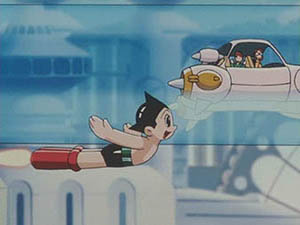
Final Cut:
Purists may very well dislike this version. They may find it a little too shiny, or think it has a little less heart. Taken on its own, though, it is an above-average anime series that attempts to entertain as well as provide a worldview that is inclusive rather than divisive. I enjoyed the show, but cannot say as much for the DVD presentation. It was shoddy to use pan & scan transfers for the show when it was made widescreen, and the exclusion of the Japanese language track is sad, especially considering that it does manage to appear on the 1980 series’ set. Adding another disc to the set may have helped make for crisper transfers too. So, I leave you with a mixed recommendation. Of the three Astro Boy series, this feels like the weakest DVD effort (besides the packaging). Opinions on the show itself are likely to be more split.
 | ||
 |







